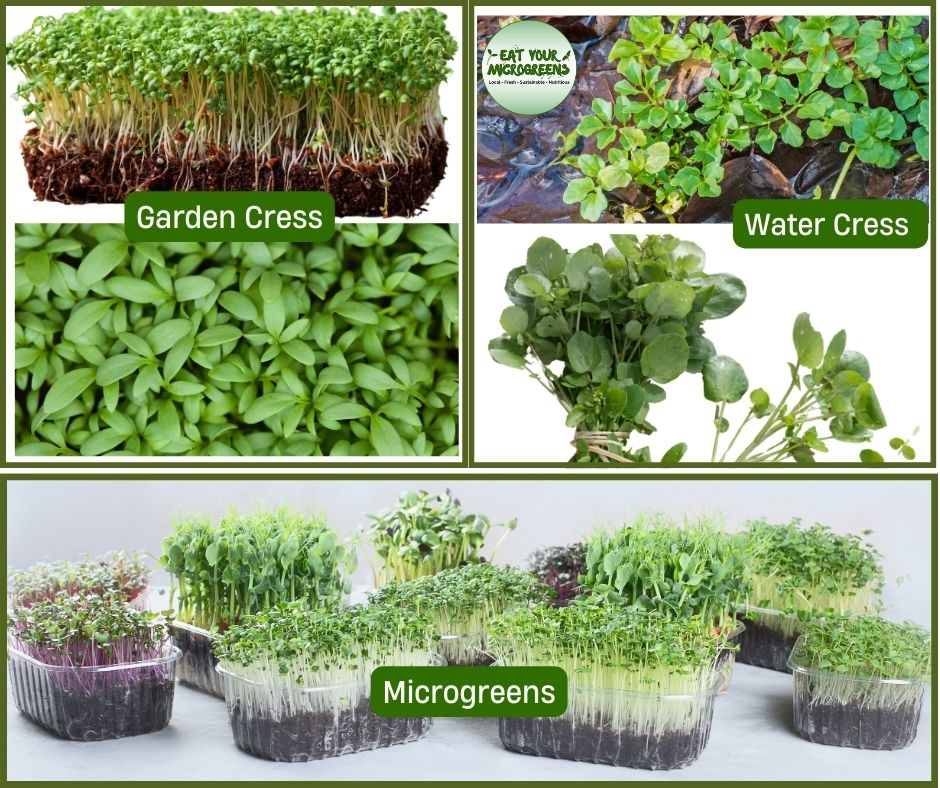
Part 2: Cress vs Microgreen -> Which came first?
Share
The question of whether the chicken or the egg came first is a classic philosophical and scientific conundrum, often posed to explore ideas of causality and the origins of life. Similarly, the microgreen vs cress debate in the Netherlands needs unpacking and further root cause analysis to help us get a better lay of the land.
History of Cress Usage
As was mentioned in the previous article: Discover the 3 Key Differences Between Microgreens & Cress, Cresses have a long history of culinary use, dating back thousands of years. It's believed that cress, particularly garden cress (Lepidium sativum), has been consumed for its culinary and medicinal properties since ancient times.
In ancient Egypt, as far back as 1550 BCE cress was cultivated and used as both food and medicine. The ancient Greeks and Romans also valued cress for its peppery flavor and its purported health benefits. They used it in salads, soups, and as a garnish.
One of the earliest recorded mentions of cress in European cuisine dates to around the 1st century CE in the writings of Pliny the Elder, a Roman naturalist and philosopher. In his work "Naturalis Historia," he described various types of cress and their uses, indicating its presence in Roman cuisine.
The precise date when cress was first eaten is difficult to pinpoint, given its long history and widespread cultivation in various cultures. However, historical records and archaeological evidence suggest that cress has been consumed for thousands of years, making it one of the earliest cultivated greens in human history.
Origin of Microgreens
Let’s begin with the term: "microgreen". This is a compound word that combines "micro" and "green." Simply coined to describe the small size and youthful green appearance of these edible plants. Here's a breakdown of the two components:
- Micro: The prefix "micro-" comes from the Greek word "mikros," meaning small or minute. It is commonly used in scientific terminology to denote something very small or on a microscopic scale.
- Green: This term refers to the color of the plants, as well as their nature as edible greens.
In a nutshell, when combined, "microgreen" describes the tiny, tender first two-leaves or shoots of edible plants that are harvested at an early stage of growth. The term captures the idea of small size while emphasizing the fresh, vibrant green color characteristic of these young plants. It effectively communicates the concept of harvesting plants at a juvenile stage for culinary use.
Additionally, the last decade has finally demonstrated what the ancient Egyptians and Romans knew about the health and nutritional benefits but were unable to measure and evaluate. In that sense, it has taken us more than 2000 years to support a tradition that has disappeared and long been overlooked. Recent health and nutrition science publications have revealed the amazing health benefits of microgreens as they are incredibly nutrient dense (measured to have more than 40 times higher than their mature counterparts), bioavailability of rich nutrients, and consist of a wide variety of nutrients all in a small bite.
The Rise of the Microgreen
Cultivating and Consuming microgreens gained momentum in the late 20th century and early 21st century, particularly in the culinary and health food industries. While it's difficult to pinpoint an exact origin, several factors contributed to the rise of the microgreen.
1. California Cuisine and Gourmet Food Trends
California Cuisine, popularized in the 1970s and 1980s, emphasized fresh, locally sourced ingredients and innovative culinary techniques. Chefs in California and other culinary hubs began experimenting with a wide variety of fresh produce, including microgreens, to enhance flavors and presentation.
2. Health and Nutrition Awareness
With increasing awareness of the health benefits of fresh fruits and vegetables, there was a growing interest in incorporating nutrient-dense foods into diets. Microgreens, harvested at an early stage of growth when they are packed with nutrients, appealed to health-conscious consumers.
3. Urban Agriculture and Home Gardening
The rise of urban agriculture and home gardening movements allowed people to grow their own food, even in limited spaces. Microgreens, which can be easily grown indoors in small containers, became a popular choice for home gardeners looking to add fresh greens to their meals.
4. Restaurant Trends and Food Media
As chefs began using microgreens to add visual appeal and flavor to their dishes, this trend gained attention in the culinary world. Food media, including cooking shows, magazines, and websites, showcased the use of microgreens in recipes, further popularizing the trend among home cooks and food enthusiasts.
5. Availability of Seeds and Growing Supplies
The availability of a wide variety of seeds and growing supplies for microgreens made it easier for individuals and businesses to start growing their own microgreens. This accessibility contributed to the widespread adoption of microgreens in both commercial kitchens and home settings.
This is an ever growing trend in the Netherlands and Europe as many people are now interested in where to buy microgreens, the health benefits, and how they can start growing today.
3 Key Differences
1. Plant Variety
-
Microgreens can come from various types of vegetables, herbs, or even grains. They are harvested when the first true leaves have developed, typically within 7-21 days after germination, depending on the plant variety. Examples of other varieties of microgreens include: broccoli, radish, sunflower shoots, pea shoots, amaranth and more.
-
Cress is scientifically known as Lepidium sativum, which belongs to the mustard family, also referred to as the Cruciferae family. The term "Cruciferae" is derived from the Latin word for cross, reflecting the characteristic cross-shaped flowers of cruciferous vegetables. This botanical family encompasses a wide range of plants, including both weeds and crop plants cultivated for consumption. Among them, garden cress, or peppergrass, stands out as one of the most commonly grown varieties.
-
Garden cress (Lepidium sativum) has a long history of cultivation and culinary use in the Netherlands, dating back centuries. In Dutch, it is known as "tuinkers" or simply "kers." Its cultivation and consumption have been popular due to its peppery flavor and nutritional value.
-
Watercress (Nasturtium officinale) has a long history of cultivation and use in Europe, dating back to ancient times
2. Flavor Profile
-
Microgreens encompass a wide range of flavors depending on the plant variety. They can be peppery, spicy, sweet, or nutty, depending on the type of plant.
-
Cress, particularly garden cress and watercress, has a distinctive peppery flavor.
3. Maturity at Harvest
-
Microgreens are harvested just after the first true leaves have developed, typically within 7-21 days of germination.
-
Cress is usually harvested at a slightly more mature stage compared to microgreens.
Baby Greens and Microgreens
To use another example of how misinformed the Dutch society is when using the word “Cress” to describe “Microgreens” the term “baby greens” comes to mind. The term "baby green" typically refers to young, tender leaves of various salad greens and leafy vegetables that are harvested at an early stage of growth. These greens are harvested when they are still small and tender, before they reach full maturity.
Unlike microgreens, which are harvested at a very early stage of growth (typically after the first true leaves have developed), baby greens are harvested slightly later in the growth process. Baby greens are larger than microgreens but still smaller and more delicate than mature leaves.
Common types of baby greens include baby spinach, baby kale, baby arugula, and various types of lettuce such as baby romaine and baby mixed greens. They are often sold pre-packaged in supermarkets or harvested fresh from home gardens or farms. Unlike Microgreens, there is an acceptance of the product and the daily use of it.
Conclusion
The food culture in the Netherlands is currently lacking in its understanding and appreciation of the traditional cultivation and consumption of microgreens, which have been utilized by ancient civilizations such as the Egyptians, Greeks, and Romans for both sustenance and medicinal purposes. This lack of awareness is compounded by the dominant presence of an industry that thrives on maintaining the status quo through scarcity-driven economics, primarily catering to high-end establishments like high-priced Michelin Star restaurants or exclusive member-only shops.
As a result, the majority of the Dutch food industry and culture mislabel and misrepresent cress equivalent to the same as a microgreen, rather than recognizing it as one variety within the broader category of microgreens. Until there is greater awareness surrounding the health benefits and historical significance of microgreens, this misrepresentation is likely to persist.
Nevertheless, despite the challenges in distinguishing between cress and microgreens, the landscape surrounding these microgreens is continuously evolving. Microgreens now symbolize a broader food movement that is gaining momentum worldwide. With an increasing number of growers, nutritionists, health experts, and conscientious eaters contributing to the popularity of microgreens, their cultivation and consumption have become widespread in culinary circles globally. This growing interest reflects a shift towards healthier eating habits and a greater appreciation for the nutritional value and culinary versatility of microgreens. As this movement continues to gather steam, it is likely to bring about greater awareness and understanding of microgreens, helping to clarify their distinctions from other greens like cress.

References:
These articles cover various aspects of microgreens, including their nutritional content, antioxidant properties, cultivation methods, and effects of environmental factors on their growth and development. You can access these articles through academic databases or university libraries for more in-depth information.
Kyriacou, M. C., and E. S. Rouphael. "Microgreens: Novel fresh and functional food to explore all the value of biodiversity." Journal of Functional Foods 40 (2018): 16-29.
Xiao, Zhenlei, and Qin Wang. "Total phenolic, flavonoid, anthocyanin, and carotenoid contents and antioxidant properties of three varieties of Brassica microgreens." Food Chemistry 239 (2018): 1157-1164.
Xiao, Zhenlei, and Qin Wang. "Pepper (Capsicum annuum) seedlings grown under high blue and red light have increased leaf area, fresh weight, antioxidant capacity, and photosynthesis compared to those grown under high-intensity discharge light." Journal of Agricultural and Food Chemistry 67.33 (2019): 9337-9344.
Yang, Tian, et al. "The content of bioactive components in broccoli as affected by the application of different fertilizers and plant protection strategies in organic production systems." Food Chemistry 268 (2018): 141-149.
Zheng, Weijian, et al. "Effects of light-emitting diode irradiation on the growth of Brassica chinensis var. parachinensis microgreens under a plant factory system." Food Chemistry 301 (2019): 125268.
